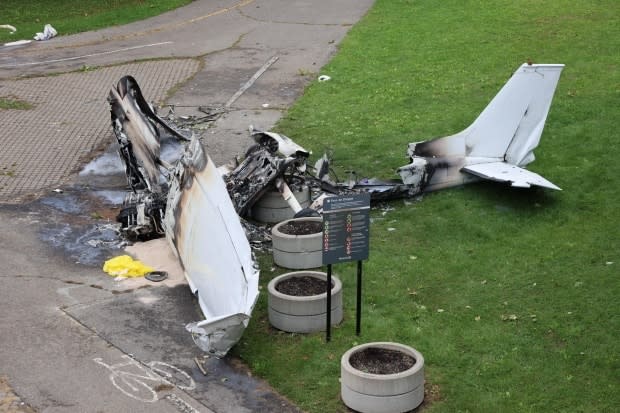Bad weather a factor in fatal 2021 crash of plane towing marriage banner in Montreal, TSB says

The Transportation Safety Board of Canada says "unfavourable weather" and engine trouble contributed to the fatal crash of a small plane towing a marriage proposal banner near Old Montreal in 2021.
The lone passenger died and the pilot was badly hurt when the Cessna 172M pulling a banner reading "will you marry me" crashed near the Concorde Bridge of Montreal's Île Sainte-Hélène on Oct. 2, 2021.
The TSB report released today says it appears the plane lost engine power somewhere over the St. Lawrence River and the pilot was forced to attempt an emergency landing.

Investigators said the plane was flying over the St. Lawrence River when the engine first began to sputter. The pilot prepared for an emergency landing on the Concorde Bridge, only to find it full of concrete construction barriers. He then tried to land on nearby Pierre-Dupuy Avenue, with tragic results.
"The aircraft's left wing grazed some treetops, the aircraft began to cartwheel, and then it struck the ground," the report said. "A post-impact fire broke out just under a minute after impact."
The badly injured pilot managed to escape the wreckage but was unable to rescue the passenger, who remained trapped inside.
While the report found no signs of mechanical engine failure in the plane, it concluded that rainy and overcast weather conditions were favourable to ice building up in the plane's carburetor, forcing the pilot to fly at a lower altitude than originally planned.
"Given the amount of ice that was quite likely in the carburetor when the carburetor heat was turned on, the melted ice entered the engine causing an additional loss of power," the report read.
The weather forced the pilot to fly at an altitude of 500 feet above sea level rather than the planned 1,200 feet, giving him little time to react when something went wrong. The flight was bound by visual flight rules, or VFR, which state the pilot should be able to keep "visual reference to the surface" and have visibility of at least three miles.
The report says the pilot decided to take off despite knowing about the poor conditions, likely due to what the TSB calls "an unconscious cognitive bias" and pressure to complete the job on time.
"Weather forecasts indicated unfavourable conditions, making it difficult to meet the minimum requirements for a VFR flight; however, the pilot decided to take off and proceed," the report said.
While the pilot held an appropriate licence, obtained in 2006, the report concluded that neither he nor the passenger should have been in the air that day.
Regulations stipulate that passengers accompanying pilots who are carrying out aerial work — such as towing banners — are only allowed if their presence is essential or with special permission, which the TSB said was not granted in this case.
Furthermore, the pilot's medical certificate had expired one day before the crash, meaning that he should not have been allowed to fly.
Neither passenger nor pilot were wearing shoulder harnesses during the flight, the report found.


